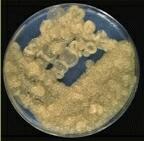The bacterial genus Xanthomonas contains organisms that resemble Pseudomonas (small, motile, Gram-negative rods), are aerobic, produce yellow pigments and typically parasitise plants. X. campestris is the most important species of the genus. It is subdivided into pathovers (pvs) based on host range, geographical distribution and other factors. For example:
However, X. campestris is perhaps even more significant as a source of commercial polysaccharide, termed xanthan or xanthan gum. |
||||
Streaked colonies of Xanthomonas campestris on an agar plate. The colonies have produced copious extracellular slime - a complex polysaccharide composed of more than one type of sugar (a heteropolymer). It is termed xanthan and has important commercial uses as a gel that is stable at relatively high temperatures. About 20,000 tonnes of xanthan are produced industrially from X. campestris each year. It is used as a gelling and stabilising agent in salad dressings, ice creams, toothpastes, cosmetics, water-based paints, etc., and also as a drilling lubricant in oil wells. The gum itself is colourless. The bacteria have a yellow pigment in the wall, but it is extractable only with organic solvents so it does not interfere with the commercial processing of xanthan. |
||||
Several other bacteria produce extracellular slimes, but with different properties that may not be as useful as those of Xanthomonas. The left-hand image below shows the copious production of slime by a Chromobacterium species. The right-hand image shows a strain of Rhizobium on a Petri dish that was incubated upside down; the slime has dripped from the colony to form a mirror image on the Petri dish lid. Such properties are not just confined to bacteria. For example, the common leaf-surface fungus Aureobasidium pullulans (see Yeasts and yeast-like fungi) is grown commercially on starch and produces the exopolysaccharide pullulan. This polymer has unique film-forming and adhesive properties that make it useful for producing a film-wrap for foods. |
||||
 |
||||
The production of extracellular polysaccharide represents a significant expenditure of energy, so we can assume that it serves some purpose. One of its roles could be to ensure a moist environment around the cells, where nutrients can diffuse through the slime. Another role could be to avoid recognition of a pathogenic bacterium by the host, because extracellular slimes do not usually have antigenic properties. Yet another role could be to restrict oxygen diffusion towards the cells - a particularly important feature for nitrogen-fixing bacteria such as Rhizobium and Azotobacter species, because the nitrogenase enzyme responsible for nitrogen fixation is extremely oxygen-sensitive. At 20oC, oxygen diffuses almost exactly 10,000 times more slowly through water than through air, so even a thin covering of hydrated slime could help to regulate the exposure of cells to oxygen. One further role of slime has been demonstrated for the important plant pathogen Pseudomonas solanacearum. This bacterium causes vascular wilt diseases of a range of crops, by gaining entry to the water-conducting (xylem) vessels. It then produces extracellular slime which blocks the vessels and leads rapidly to plant death [see Vascular Wilts]. Further reading:
Websites:
|
||||

